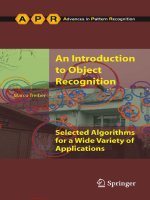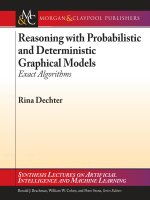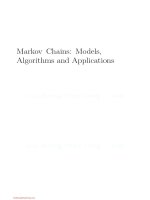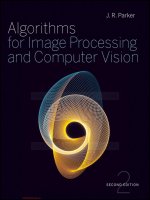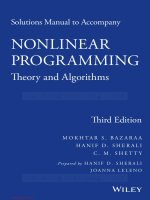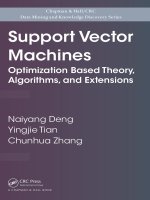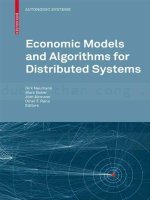economic models and algorithms for distributed systems neumann, baker, altmann rana 2009 12 04 Cấu trúc dữ liệu và giải thuật
Bạn đang xem bản rút gọn của tài liệu. Xem và tải ngay bản đầy đủ của tài liệu tại đây (4.61 MB, 263 trang )
CuuDuongThanCong.com
AUTONOMIC SYSTEMS
Series Editors:
Frances M.T. Brazier (VU University, Amsterdam, The Netherlands)
Omer F. Rana (Cardiff University, Cardiff, UK)
John C. Strassner (POSTECH, Pohang, South Korea)
Editorial Board:
Richard Anthony (University of Greenwich, UK)
Vinny Cahill (Trinity College Dublin, Ireland)
Simon Dobson (University of St. Andrews, UK)
Joel Fleck (Hewlett-Packard, Palo Alto, USA)
José Fortes (University of Florida, USA)
Salim Hariri (University of Arizona, USA)
Jeff Kephart (IBM Thomas J. Watson Research Center, Hawthorne, USA)
Manish Parashar (Rutgers University, New Jersey, USA)
Katia Sycara (Carnegie Mellon University, Pittsburgh, USA)
Sven van der Meer (Waterford Institute of Technology, Ireland)
James Won-Ki Hong (Pohang University, South Korea)
The AUTONOMIC SYSTEMS book series provides a platform of communication
between academia and industry by publishing research monographs, outstanding PhD theses, and peer-reviewed compiled contributions on the latest
developments in the field of autonomic systems.
It covers a broad range of topics from the theory of autonomic systems that are
researched by academia and industry. Hence, cutting-edge research, prototypical case studies, as well as industrial applications are in the focus of this
book series. Fast reviewing provides a most convenient way to publish latest
results in this rapid moving research area.
The topics covered by the series include (among others):
•
•
•
•
•
self-* properties in autonomic systems (e.g. self-management, self-healing)
architectures, models, and languages for building autonomic systems
trust, negotiation, and risk management in autonomic systems
theoretical foundations of autonomic systems
applications and novel computing paradigms of autonomic systems
CuuDuongThanCong.com
Economic Models
and Algorithms for
Distributed Systems
Dirk Neumann
Mark Baker
Jörn Altmann
Omer F. Rana
Editors
Birkhäuser
Basel · Boston · Berlin
CuuDuongThanCong.com
Editors:
Dirk Neumann
Chair for Information Systems
Kollegiengebäude II
Platz der Alten Synagoge
79085 Freiburg
Germany
e-mail:
Jörn Altmann
Technology Management, Economics
& Policy Program
College of Engineering
Seoul National University
San 56-1, Shillim-Dong,
Gwanak-Gu, Seoul 151-742
South Korea
e-mail:
Mark Baker
Research Professor of Computer Science
ACET Centre, School of Systems Engineering
The University of Reading
Whiteknights, Reading
Berkshire RG6 6AY
UK
e-mail:
Omer Rana
School of Computer Science
Cardiff University
Queen‘s Buildings, Newport Road
Cardiff CF24 3AA
UK
e-mail:
1998 ACM Computing Classification: C.2.4 [Distributed Systems]; C.2.1 [Network Architecture and Design]: Distributed networks: Network communications; C.2.3 [Network
Operations]; C.4 [Performance of Systems]; H.3.4 [Systems and Software]: Distributed
systems; I.2.11 [Distributed Artificial Intelligence]; K.6.4 System Management
Library of Congress Control Number: 2009931265
Bibliographic information published by Die Deutsche Bibliothek.
Die Deutsche Bibliothek lists this publication in the Deutsche Nationalbibliografie;
detailed bibliographic data is available in the Internet at
ISBN 978-3-7643-8896-6 Birkhäuser Verlag AG, Basel – Boston – Berlin
This work is subject to copyright. All rights are reserved, whether the whole or part of the
material is concerned, specifically the rights of translation, reprinting, re-use of illustrations, recitation, broadcasting, reproduction on microfilms or in other ways, and storage
in data banks. For any kind of use permission of the copyright owner must be obtained.
© 2010 Birkhäuser Verlag AG
Basel · Boston · Berlin
P.O. Box 133, CH-4010 Basel, Switzerland
Part of Springer Science+Business Media
Printed on acid-free paper produced from chlorine-free pulp. TCF∞
ISBN 978-3-7643-8896-6
e-ISBN 978-3-7643-8899-7
987654321
www.birkhauser.ch
CuuDuongThanCong.com
Contents
Economic Models and Algorithms for Distributed Systems . . . . . . . . . . . .
Part I:
1
Reputation Mechanisms and Trust
Ali Shaikh Ali and Omer F. Rana
A Belief-based Trust Model for Dynamic Service Selection . . . . . . . . . . . .
9
Arun Anandasivam and Dirk Neumann
Reputation, Pricing and the E-Science Grid . . . . . . . . . . . . . . . . . . . . . . . .
25
Georgia Kastidou and Robin Cohen
Trust-oriented Utility-based Community Structure in Multiagent
Systems . . . . . . . . . . . . . . . . . . . . . . . . . . . . . . . . . . . . . . . . . . . . . . . . . . . .
45
Thomas E. Carroll and Daniel Grosu
Formation of Virtual Organizations in Grids: A Game-Theoretic
Approach . . . . . . . . . . . . . . . . . . . . . . . . . . . . . . . . . . . . . . . . . . . . . . . . . . .
63
Jürgen Mangler, Erich Schikuta, Christoph Witzany, Oliver Jorns,
Irfan Ul Haq and Helmut Wanek
Towards Dynamic Authentication in the Grid – Secure and Mobile
Business Workflows Using GSet . . . . . . . . . . . . . . . . . . . . . . . . . . . . . . . . .
83
Part II: Service Level Agreements
Mario Macías, Garry Smith, Omer Rana, Jordi Guitart and
Jordi Torres
Enforcing Service Level Agreements Using an Economically Enhanced
Resource Manager . . . . . . . . . . . . . . . . . . . . . . . . . . . . . . . . . . . . . . . . . . . .
CuuDuongThanCong.com
109
VI
Contents
Tim Püschel, Nikolay Borissov, Dirk Neumann, Mario Macías,
Jordi Guitart and Jordi Torres
Extended Resource Management Using Client Classification and
Economic Enhancements . . . . . . . . . . . . . . . . . . . . . . . . . . . . . . . . . . . . . . .
129
Chris Smith and Aad van Moorsel
Mitigating Provider Uncertainty in Service Provision Contracts . . . . . . . .
143
Axel Tenschert, Ioannis Kotsiopoulos and Bastian Koller
Text-Content-Analysis based on the Syntactic Correlations between
Ontologies . . . . . . . . . . . . . . . . . . . . . . . . . . . . . . . . . . . . . . . . . . . . . . . . . .
161
Part III: Business Models and Market Mechanisms
Ashraf Bany Mohammed, Jörn Altmann and Junseok Hwang
Cloud Computing Value Chains: Understanding Businesses and Value
Creation in the Cloud . . . . . . . . . . . . . . . . . . . . . . . . . . . . . . . . . . . . . . . . .
187
In Lee
A Model for Determining the Optimal Capacity Investment for Utility
Computing . . . . . . . . . . . . . . . . . . . . . . . . . . . . . . . . . . . . . . . . . . . . . . . . . .
209
Melanie Moßmann, Jochen Stößer, Adam Ouorou, Eric Gourdin, Ruby
Krishnaswamy and Dirk Neumann
A Combinatorial Exchange for Complex Grid Services . . . . . . . . . . . . . . .
221
Christian Bodenstein
Heuristic Scheduling in Grid Environments: Reducing the Operational
Energy Demand . . . . . . . . . . . . . . . . . . . . . . . . . . . . . . . . . . . . . . . . . . . . . .
239
Raimund Matros, Werner Streitberger, Stefan Koenig and
Torsten Eymann
Facing Price Risks in Internet-of-Services Markets . . . . . . . . . . . . . . . . . . .
257
CuuDuongThanCong.com
Economic Models and Algorithms for Distributed Systems, 1–3
Book Series: Autonomic Systems
© 2009 Birkhäuser Verlag Basel/Switzerland
Economic Models and Algorithms for
Distributed Systems
Modern computing paradigms have frequently adopted concepts from distributed
systems. The quest for scalability, reliability and cost reduction has led to the development of massively distributed systems, which extend organisational boundaries. Voluntary computing environments (such as BOINC), Grids (such as EGEE
and Globus), and more recently Cloud Computing (both open source and commercial) have established themselves as a range of distributed systems.
Associated with this advance towards cooperative computing, the paradigm
of software agents generally assumes that cooperation is achieved through the use
of obedient agents that are under centralised control. In modern distributed systems, this main assumption is no longer valid. On the contrary, cooperation of
all agents or computing components is often necessary to maintain the operation
of any kind in a distributed system. Computer scientists have often considered
the idea that the components of the distributed system are pursuing other selfish
objectives, other than those that the system designer had initially in mind, when
implementing the system. The peer-to-peer file sharing systems, such as BitTorrent and Gnutella, epitomise this conflict of interest, because as low as 20% of
the participants contribute more than 80% of the files. Interestingly, various distributed systems experience different usage patterns. While voluntary computing
environments prospered through the donation of idle computing power, cooperative systems such as Grids suffer due to limited contribution from their participants. Apparently, the incentive structure used to contribute to these systems can
be perceived differently by the participants.
Economists have also demonstrated research interest in distributed systems,
exploring incentive mechanisms and systems, pioneered by Nobel-prize winners
von Hayek and Hurwicz in the area of incentives and market-based systems. As
distributed systems obviously raise many incentive problems, economics help complement computer science approaches. More specifically, economics explores situations where there is a gap between individual utility maximising behaviour and
socially desirable deeds. An incorrect balance between such (often conflicting)
objects could lead to malfunctioning of an entire system. Especially, cooperative
computing environments rely on the contribution of their participants. Research
test beds such as EGEE and PlanetLab impose regulations on the participants
CuuDuongThanCong.com
2
Dirk Neumann et al.
that contribute, but the enforcement of these institutions is informal by the loss
of reputation.
While such a system is dependent on the reputation of the participants that
work in academia, a commercial uptake has been limited. In the past, it became
evident that cooperative computing environments need incentive mechanisms that
reward contribution and punish free-riding behaviour. Interestingly, research on
incentive mechanisms in distributed systems started out in economics and computer science as separate research streams. Early pioneers in computer science
used very simple incentive mechanisms in order to align individual behaviour with
the socially desirable deeds. The emphasis was on the implementation of these
mechanisms in running computing environments. While these studies demonstrate that it is possible to combine the principles of economics in sophisticated
(Grid) middleware, it has also become evident that the mechanisms were too simple to overcome the effects of selfish individual behaviour. Interestingly, research
in economics pursued a diametrically opposing approach. Abstracting from the
technical details of the computing environments, were sophisticated mechanisms
were developed that demonstrated desirable economic properties. However, due
to the abstract nature of these mechanisms a direct implementation is not always
possible.
It is, nevertheless, interesting to see that these initially different research
streams have been growing together in a truly inter-disciplinary manner. While
economists have improved their understanding of overall system design, many computer scientists have transformed into game theory experts. This amalgamation
of research streams has produced workable solutions for addressing the incentive
problems in distributed systems.
This edited book contains a compilation of the most recent developments of
economic models and algorithms in distributed systems research. The papers were
selected from two different workshops related to economic aspects in distributed
systems, which were co-located with the IEEE Grid 2007 conference in Austin and
with the ACM MardiGras 2008 conference in Baton Rouge. The extended papers
from these events have been added to by projects being funded by the European
Union, which in particular, address economic issues in Grid systems. As Grid
computing has evolved towards the use of Cloud infrastructure, the developed
economic algorithms and models can similarly be utilised in this new context – in
addition to further use within peer-to-peer systems.
This book inevitably emphasises computing services, which look at the economic issues associated with contracting out and the delivery of computing services. At the outset of each service delivery the question arises, which service
request will be accommodated at what price, or is it even provided free of charge.
As these issues are spawned around business models and in particular around
markets as a special kind of business model, the first chapter is devoted to the
exploration of these questions. Once it has been determined, in order to resolve
which service request should be accepted, a formal contract needs to be defined
CuuDuongThanCong.com
Economic Models and Algorithms for Distributed Systems
3
and mutually signed between service requester and provider. The second chapter
of the book deals with aspects of service-level agreements (SLAs). One particular
emphasis is on how infrastructure providers (e.g. Cloud vendors) maximise their
profit, such that the Quality of Service (QoS) assertions specified in the SLA are always maintained. In the last phase of the transaction chain stands the enforcement
of the SLAs. In case of detected SLA infringements (which may be by the client
or the provider, but with a focus generally on the provider), penalty payments
will be need to be paid by the violating provider. If the services are small-scale,
it is in many cases too costly to enforce penalty payments by law. Thus, there is
a need to enforce the SLAs without formal legal action; otherwise the contracts
would prove to be worthless. A current practice is to establish trust among the
service providers by means of reputation systems. Reputation systems embody an
informal enforcement, where the SLA violators are not punished by the requester,
whose SLA was breached, but by the community, which may subsequently limit
use of the service offering from the respective provider. The design of reputation
mechanisms is often quite difficult to undertake in practice, as it should reflect the
actual potency of a provider and not be politically motivated.
CuuDuongThanCong.com
Part I:
Reputation Mechanisms and Trust
CuuDuongThanCong.com
Economic Models and Algorithms for Distributed Systems, 7–8
Book Series: Autonomic Systems
© 2009 Birkhäuser Verlag Basel/Switzerland
Reputation Mechanisms and Trust
Reputation mechanisms and trust as well as Service Level Agreements, addressed
in the previous section are somewhat complementary. Whereas SLAs primarily encode contractual obligations between consumers and providers, reputation models
enable choice of providers based on their past performance (assuming provider
identity is persistent or traceable), or on their ability to deliver on these contractual obligations over time. Where “trust” is often defined between two participants,
“reputation” often involves aggregating views from a number of different sources.
It is useful to note that when developing reputation mechanisms, not all aspects (i.e. capabilities offered by a provider) need to be considered as part of the
reputation model – hence, depending on the context of usage, reputation may be
calculated differently. This forms the basis for the reputation model from Ali and
Rana in their chapter “Belief-based Trust Model for Dynamic Service Selection”,
where reputation is calculated based on the particular context of use, or subjective
belief of a participant. The authors attempt to combine various views on reputation and trust, depending on how these terms are perceived by a user. They
subsequently demonstrate how trust may be used as a selection criterion between
multiple service providers.
Anandasivam and Neumann continue this theme in their chapter “Reputation, Pricing and the E-Science Grid ” by focusing on how the use of reputation
can be used to incentivise a provider, essentially preventing such a provider from
terminating a computational job from a client, even though the provider could
make greater revenue by running an alternative computational job. Their work
compares job submission with sites that do (and do not) use reputation mechanisms, and discuss how price determination can be associated with reputation –
and present the associated decision model that may be used by market participants. Most importantly, they demonstrate that the correct use of price setting
enables better collaborative interactions between participants.
The next two chapters focus on the formation of communities and virtual
organizations in order to allow participants to maximise their reward (or “utility”).
Kastidou and Cohen in their chapter “Trust-oriented Utility-based Community
Structure in Multiagent Systems” discuss how better community structures could
be established by allowing their participants to exchange reputation information.
In this way, reputation may serve as either an incentive or a barrier to entry
for an agent attempting to join another community. The focus of their work is
CuuDuongThanCong.com
8
Dirk Neumann et al.
on the incentive mechanisms for communities to truthfully and accurately reveal
reputation information, and the associated privacy concerns about disclosing such
information to others. Their work is particularly relevant in open environments, as
exemplified through file sharing Peer-2-Peer systems, where a decision about what
files to share (upload/download) and from which participants, becomes significant.
The chapter from Carroll and Grosu entitled “Formation of Virtual Organizations in Grids: A Game-Theoretic Approach”, has a similar focus. They consider
the formation of Virtual Organizations (VOs) which involves the aggregation of
capacity from various service providers –which has a similar scope, although a
different focus (on application/job execution, rather than community structure)
to the notion of communities in the chapter by Kastidou and Cohen. They discuss
incentive mechanisms that would enable self interested Grid Service Providers
(GSPs) to come together to form such VOs using a coalitional game-theoretic
framework. They demonstrate how given a deadline and a budget, VOs can form
to execute particular jobs, and then dissolve. They use Myerson’s cooperation
structure to achieve this, and rely on the assumption that GSPs exhibit welfare
maximising behaviours when participating in a VO.
A last chapter in this section looks more at the payment issue emphasizing
the business perspective of cooperative computing infrastructures. The paper “Towards Dynamic Authentication in the Grid -Secure and Mobile Business Workflows
using GSet” by Mangler, Schikuta, Witzany, Jorns, Ul Haq and Wanek introduce
the use of gSET (Gridified Secure Electronic Transaction) as a basic technology for
trust management and secure accounting in cooperative computing environments.
CuuDuongThanCong.com
Economic Models and Algorithms for Distributed Systems, 9–23
Book Series: Autonomic Systems
© 2009 Birkhäuser Verlag Basel/Switzerland
A Belief-based Trust Model for Dynamic
Service Selection
Ali Shaikh Ali and Omer F. Rana
Abstract. Provision of services across institutional boundaries has become an
active research area. Many such services encode access to computational and
data resources (comprising single machines to computational clusters). Such
services can also be informational, and integrate different resources within an
institution. Consequently, we envision a service rich environment in the future, where service consumers can intelligently decide between which services
to select. If interaction between service providers/users is automated, it is
necessary for these service clients to be able to automatically chose between
a set of equivalent (or similar) services. In such a scenario trust serves as
a benchmark to differentiate between service providers. One might therefore prioritize potential cooperative partners based on the established trust.
Although many approaches exist in literature about trust between online communities, the exact nature of trust for multi-institutional service sharing remains undefined. Therefore, the concept of trust suffers from an imperfect
understanding, a plethora of definitions, and informal use in the literature.
We present a formalism for describing trust within multi-institutional service
sharing, and provide an implementation of this; enabling the agent to make
trust-based decision. We evaluate our formalism through simulation.
1. Introduction
The existence of online services facilitates a novel form of communication between
individuals and institutions, supporting flexible work patterns and making an institutional’s boundaries more permeable. Upcoming standards for the description
and advertisement of, as well as the interaction with and the collaboration between
on-line services promise a seamless integration of business processes, applications,
and online services over the Internet. As a consequence of the rapid growth of
on-line services, the issue of trust becomes significant. There are no accepted
CuuDuongThanCong.com
10
Ali Shaikh Ali and Omer F. Rana
techniques or tools for specification and reasoning about trust. There is a need for
a high-level, abstract way of specifying and managing trust, which can be easily
integrated into applications and used on any platform. The need for a trust-based
decision becomes apparent when service consumers are faced with the inevitability
of selecting the right service in a particular context. This assumes that there is
likely to be a service-rich environment (i.e. a large number of service providers)
offering similar types of services. The distributed nature of these services across
multiple domains and organizations, not all of which may be trusted to the same
extent, makes the decision of selecting the right service a demanding concern, especially if the selection proves is to be automated and performed by an intelligent
agent.
We present a formalized approach to manage trust in online services. Our
work contributes the following to the research in this field: (1) a detailed analysis of the meaning of trust and its components; (2) a trust model based on a
socio-cognitive approach; (3) a trust adaptation approach; (4) an approach for
service selection based on trust (using different criteria). The remainder of this
article is structured as follows. First, we provide an overview of related work (Section 3.). We then present a brief overview of methodology we apply for deriving
the formalism, in Section 4.. In Section 5. a discussion of the trust system and its
components is presented. In Section 7. we present our approach, and the evaluate
it in Section 8..
2. Motivations
In order to exemplify our trust formalism we will apply it to a particular scenario,
based on the Faehim (Federated Analysis Environment for Heterogeneous Intelligent Mining) toolkit [8]. The aim of the Faehim project is to develop machine
learning Web Services and combine them using the Triana workflow engine for
Web Services composition. The scenario involves a user confronted with the inevitability of selecting a machine learning Web Service within the workflow. The
potential number of suitable services is large, and services are deployed with different qualities, i.e. speed, reliability, etc. The scenario makes use of multiple
such services (such as a regression technique, a clustering technique, etc). In such
a scenario, the user should make a trust-based selection that enables service prioritization based on their beliefs about service quality. It is intended that the user
should select a service that most matches his trust preferences or policy.
3. Related work
The general notion of trust is excessively complex and appears to have many
different meanings depending on how it is used. There is also no consensus in
the computer and information sciences literature on what trust is, although its
CuuDuongThanCong.com
A Belief-based Trust Model for Dynamic Service Selection
11
importance has been widely recognized and the literature available on trust is
substantial. Broadly speaking, there are two main approaches to trust introduced
in the literature. The first approach aims to allow agents to trust each other
and therefore there is a need to endow them with the ability to reason about
the reliability or honesty of their counterparts. This ability is captured through
trust models. The latter aim to enable agents to calculate the amount of trust
they can place in their interaction partners. This is achieved by guiding agents
on decision making in deciding on how, when and who to interact with. An agent
in this context refers to either a service user or a provider. However, in order to
do so, trust models initially require agents to gather some knowledge about their
counterparts. This has been achieved in three ways in the literature:
1. A Presumption drawn from the agent’s own experience: Trust is computed as
a rating of the level of performance of the trustee. The trustee’s performance
is assessed over multiple interactions to check how good and consistent it is
at doing what it says it does. To this end, Witkowski et al. [10] propose a
model whereby the trust in an agent is calculated based on its performance
in past interactions. Similar to Witkowski et al., Sabater et al. [9] (using
the REGRET system) propose a similar model but do not just limit the
overall performance to the agent’s direct perception, but they also evaluate
its behavior with other agents in the system.
2. Information gathered from other agents: Trust in this approach is drawn indirectly from recommendations provided by others. As the recommendations
could be unreliable, the agent must be able to reason about the recommendations gathered from other agents. The latter is achieved in different ways:
(1) deploying rules to enable the agents to decide which other agents’ recommendation they trust more, as introduced by Abdul-Rahman et al. [1];
(2) weighting the recommendation by the trust the agent has in the recommender, EigenTrust [5] and PageRank [7] are examples of this approach.
3. Socio-cognitive trust: Trust is drawn by characterizing the known motivations of the other agents. This involves forming coherent beliefs about different characteristics of these agents and reasoning about these beliefs in order
to decide how much trust should be put in them. An example of this is work
by Castelfranchi [3].
While trust models pertain to the reasoning and information gathering ability of
agents, the second main approach to trust concerns the design of protocols and
mechanism of interaction. A common protocol for interaction is user authentication – a common technique found in many types of applications. This involves a
username/password combination to access a service. A common variation to this
technique is the use of Digital Certificates to verify a user’s identity. This verification is done through a third agent that creates a unique encrypted certificate
for every user machine. The certificate is then submitted when the user makes a
request to another agent.
CuuDuongThanCong.com
12
Ali Shaikh Ali and Omer F. Rana
4. The methodology
A difficult issue when discussing trust is that the phenomenon is such a subjective
one [6]. It is difficult to provide a comprehensive definition for trust, and is the
reason why previous studies have failed to provide a detailed definition. Previous
projects have therefore restricted themselves to just one or two of the several aspects of trust. In our approach, instead of starting with a definition and developing
a formalism, we start with intuitive ideas about how trust works by breaking down
the components of trust, coupled with investigation of how these components may
be aggregated to support a trust decision, and attempting to develop a formalism
around this decision process. The advantage of this approach is that we will cover
more or less many aspects of trust in the formalism. In addition, having studied the components of trust, we could make use existing literature to derive the
formalism.
5. Trust components
Currently there is no consensus on a precise definition of trust nor its basic components. However, there is a general agreement on the subjective nature of trust.
Consider for example the definition of trust provided by Gambetta [4]: “Trust is
a particular level of the subjective probability with which an agent assesses that
another agent will perform a particular action.” The definition stresses that trust
is basically an estimation, an opinion and an evaluation. Similarly, the Oxford
Reference Dictionary defines trust as a belief: “Trust is the firm belief in the reliability or truth or strength of an entity.” Trust can also be related to the role
undertaken by an individual in a particular context, based on the specific goals
and priorities of that role. Essentially therefore, trust means different things to
different people, to different roles, and in different scenarios. Trust can mean such
things as the following:
• Do I believe that what someone says is true and factual?
• Do I agree with a person or an organisation’s goal, or what they stand for?
• Do I believe that a person or organisation’s goal(s) and/or priorities match
mine?
The above discussion leads us to draw an explicit terminology for trust. As our
intention is to allow a client to make a trust-based decision for selecting service
providers, we specify trust as an assumption or an expectation we make about
others in some context/environment. This expectation is based upon more specific
beliefs which form the basis or the components of trust [3]. These are beliefs
relating to a provider that a client wishes to trust. Such beliefs are the answer for
the question: “What do we have in mind when we trust a service?” For example,
we may trust a service because we believe that service is able to do what we need
(competence) and it will actually do it quickly (promptness). Competence and
CuuDuongThanCong.com
A Belief-based Trust Model for Dynamic Service Selection
13
promptness are therefore examples of the basic belief and mental state components
of trust, in this instance. Hence, the importance of any particular criteria is
dependent on the client making use of a service. Some clients may be interested
in promptness, and others in accuracy. We therefore take account of the fact that
trust values may need to be defined with reference to different criteria. We may
classify beliefs according to the context of service provision into the following:
1. Non-situational beliefs: These beliefs concern the trustee, and do not relate
to the currently on-going transaction. Institutional beliefs include:
• Competence Belief: the ability of a service provider to accomplish a task,
such as providing accurate results or performing a desired action [3].
• Availability Belief: a belief that the service will be on-line and available
when a request to it is sent.
• Promptness Belief: The speed at which the service responds to task
requests by accomplishing the agreed upon task.
• Cost Belief: Cost refers to the monetary value that the user is willing
to pay.
2. Situational beliefs: These beliefs concern the situation of the truster and the
benefit that he will get from the trusting decision. Situational beliefs include:
• Harmfulness Belief: These beliefs concern the risks of propagating a
task (or data) for execution (or processing) to a given service provider.
• Importance Belief: These beliefs concern the user-centered judgment of
the importance of the task. The greater the importance, the greater the
likelihood to trust. This indicates that if accomplishment of a particular
task is significant to a client, there will be a greater importance in the
need to trust the service provider.
• Utility Belief: Utility refers to the benefits that the user will gain from
the task being successfully completed.
Several benefits can be derived from exploring the various types of beliefs. A
client may therefore prioritize potential service providers based on evaluating the
beliefs outlined above. For example, if a client knows that a goal must be achieved
quickly, even at the price of reduced accuracy, then the client might rank Web
Services based on availability and promptness, with less concern for accuracy –
such as intent or competence. If however, the goal must be accomplished with
exact correctness, intent and competence, then these beliefs take precedence in
the prioritization of Web services.
5.1 The sources of beliefs
Beliefs can come from two sources: the direct experience of a client, or as an
acceptance of recommendations made by other clients of a particular provider.
We classify the sources of beliefs into:
CuuDuongThanCong.com
14
Ali Shaikh Ali and Omer F. Rana
1. Self-generated belief: Self-generated beliefs are those that a client creates
itself.
• Direct experience: this means trying things out in practice, observing
things and generally getting obtaining suitable evidence before committing to a belief. In reality, a client may only have time to try a limited
number of operations.
2. Externally generated belief: The alternative to generating beliefs through
a client is to utilize comments generated by other clients. Sources in this
category include:
• Recommendations: these constitute a form of advice from another client
or organization (and are weighted by the trust placed in the recommender itself).
• Reputation: this is a term that lacks a widely accepted definition. In
our framework we define it as how other users feels about the behavior
of a particular service provider. This may constitute an aggregate of
views from multiple users about a single provider.
6. Illustrating beliefs
We present beliefs as a diagram – as a second step towards a formalism. From
Figure 1, beliefs are represented by a circle where the circle indicates the type of
the belief. The sources of the beliefs are represented by rectangles. The value
that the source creates is written on the arrow. We also propose a weight for the
source and present it as a small square at the top left of the source’s rectangle.
The weight value indicates how much we rely on that source. More about weights
in Section 7.2.
7. Deriving a trust formalism
In this section we outline how a trust formalism may be derived using the concepts
discussed in previous sections.
7.1 Combining belief values from various sources
The value of a belief should reflect the accumulation of all values produced by various sources, combined with the uncertainty associated with the nature of these
sources. Two issues should be considered: (1) how the belief values can be combined, and (2) how do we deal with the uncertain nature of the belief sources.
For the first issue, Castelfranchi et al. [3] propose an implementation for computing the trust value for the socio-cognitive model using Fuzzy Cognitive Maps
(FCM). An FCM is an additive fuzzy system with feedback; it is well suited for
CuuDuongThanCong.com
A Belief-based Trust Model for Dynamic Service Selection
15
Figure 1. A complete scenario.
representing a dynamic system with cause-effect relations. An FCM has several
nodes; representing belief sources, and edges, representing the casual power of a
node over another one. The values of all the edges are assigned by a human and
propagate in the FCM until a stable state is reached; so the values of the other
nodes are computed. Two main problems are deduced from the FCM approach:
(1) FCM does not take the uncertainty associated with sources into consideration,
and (2) FCM assumes a human interaction to assign the value to the edges, which
is limiting if the aim is to automate the trust decision.
It is possible to characterize the uncertainty associated with a given belief
using a probability measure. However, the recent criticisms of the probabilistic
characterization of uncertainty claim that traditional probability theory is not
capable of capturing subjective uncertainty. The application of traditional probabilistic methods to subjective uncertainty often utilizes Bayesian probability. An
additional assumption in classical probability is entailed by the axiom of additivity, where all probabilities that satisfy specific properties must add to 1. This
forces the conclusion that knowledge of an event necessarily entails knowledge of
CuuDuongThanCong.com
16
Ali Shaikh Ali and Omer F. Rana
the complement of an event, i.e., knowledge of the probability of the likelihood of
the occurrence of an event can be translated into the knowledge of the likelihood
of that event not occurring.
As a consequence of these concerns, many more general representation of
uncertainty to cope with particular situations involving uncertainty have been
proposed. Dempster–Shafer Theory (DST) is a theory that was developed to cope
with such particular situation. We use DST to combine trusting beliefs. The DST
will be applied on all the beliefs obtained from the various sources.
7.2
Weighted Dempster–Shafer theory
Based on standard Dempster–Shafer theory, let the universal set be donated θ.
Elements of θ represents mutually exclusive hypothesis. In our case, these elements represent one of the core beliefs in trust, i.e. competence, promptness, etc.
With the universe of discernment θ defined, each source Si would contribute its
observation by assigning its belief values over θ. This assignment function is called
the basic probability assignment (BPA) of Si , denoted mi . Formally, one defines
BPA as the mapping, m : 2θ → [0, 1] that satisfies
m(A) = 1 .
A⊆θ
Often, m(φ) = 0, where φ is the null set. The belief in a subset B ⊂ θ is then
defined as
bel(A) =
m(B) .
B⊆A
This indicates that belief in A can also be characterised with respect to a subset
of A. DST assumes practical relevance since it is possible to revise the estimates
based on information that may be available from additional (independent) sources.
Suppose, for example that the estimate from one source is denoted by m1 (A) and
that from the other sources is denoted as m2 (A). Dempster’s rule of combination
provides a belief function based on the combined evidence. The conjunctive rule of
combination handles the case where both sources of information are fully reliable.
The result of the combination is a joint BPA representing the conjunction of the
two pieces of evidence induced from the two sources. This rule is defined as
(m1 ∩ m2 )(A) =
m1 (B)m2 (C) .
B,B⊆θ,B∩C=A
This is the un-normalized Dempster’s rule of combination. If necessary, the normality assumption may be recovered by dividing each value by a normalisation
coefficient:
(m1 ∩ m2 )(A)
(m1 ⊕ m2 )(A) =
, ∀φ = A ⊆ θ
a − m(φ)
CuuDuongThanCong.com
A Belief-based Trust Model for Dynamic Service Selection
17
where the quantity m(φ) is called the degree of conflict between m1 and m2 and
can be computed using
m(φ) = (m1 ∩ m2 )(φ) =
m1 (B)m2 (C) .
B∩C=φ
The fundamental DST combination rule implies that we trust any two sources
Si and Sj equally. However, these sources are not always reliable and we usually
trust some sources more than others, i.e. one might have greater belief values
from ones own experience than belief values from received recommendations. This
sort of deferential trust can be accounted for by a simple modification to DST,
in which the observations mi are weighted by trust factors wi derived from the
corresponding expectations, histories of the corresponding source Si ’s performance.
The weighting process has already been investigated by Basak et al. [2]. Their
proposed formula of weighted DMS is defined as follows:
m1
where
denotes the combination with usual Dempster’s rule and
mi =
7.3
m2 = m1 ∩ m2
mwi
i (A)
.
wi
B⊆θ mi (B)
Trust adaptation: Dynamic weighting
When the ground truth is available, e.g. shortly after current measurements or
from additional information channels, it can be used by making the weight factors
wi as functions of time. A simple but effective practical implementation of such
an approach is to define:
∞
1
wi =
ci (n).
n
n=0
where ci (n) is the function describing the correctness of source Si ’s estimation at
time n:
0 correct estimation
ci (n) =
1 incorrect estimation
and the n1 is the “penalty factor”, which is used to control the changes of the weight
value. We aim from this penalty factor to:
• Increase the weight of the source by a large value if it gives correct estimation
at the first stages and vice versa.
• Increase the weight of the source by a small value at later stages.
CuuDuongThanCong.com
18
Ali Shaikh Ali and Omer F. Rana
7.4
Trust computation and selection
Using weighted DST, it is not possible to compute the aggregated values for a
belief from different independent sources. The next step is to aggregate the beliefs
to derive a single “trust value”. The trust value forms a benchmark for selecting
services. In our case, the service that has the highest trust value is selected. Each
belief influences the trust value and is associated with an influence factor k. This
value indicates how a belief influences the eventual trust decision. The value of k
is either positive or negative in the range [-1..1], such that:
w:
>= 0 when the belief promotes the trust value
<0
when the belief inhabits the trust value .
For example, the k for the promptness belief might be assigned a positive
value as it promotes trust, whereas the k for the harmfulness belief might be
assigned a negative value as it inhabits trust. The trust value is computed as the
sum of all the influencing beliefs:
n
trustvalue =
ki ∗ belief i
i=0
where n is the number of the influencing beliefs, ki is the weight of the belief i .
8. Empirical evaluation
The primary goal of our evaluation is to show empirically that the formalism works
and enables the system to make a service selection based on a trust-decision. The
experiment is made up of a series of simulations. We first give an overview of the
environment for the simulations and then discuss the expected and actual results
followed by a discussion of the results.
8.1
Environment overview
We construct a simulation that allows the creation of different types of consumers
in Java. Each consumer can have its own trust preference or policy. The simulation
also allows the creation of user-specified belief sources, e.g. reputation, experience,
etc. The following simulation parameters can also be specified:
• Service Quality Adjustments: these are runtime behavioural modifications to
a service, specified to affect the execution performance of a service.
• Belief Source Adjustments: these are runtime behavioural modifications to a
belief source, specified to affect the accuracy of the replicated belief values.
CuuDuongThanCong.com
A Belief-based Trust Model for Dynamic Service Selection
Figure 2. Simulation 1.
Figure 3. Simulation 2.
Figure 4. Simulation 3.
CuuDuongThanCong.com
19
20
Ali Shaikh Ali and Omer F. Rana
Figure 5. Simulation 4.
8.2
Setup summary
We conducted four simulations for this experiment. Each simulation consists
of three groups of four identical machine learning services and three consumers.
These machine learning services are based on the Faehim toolkit [8]. The machine
learning services implement the J48 machine learning algorithm – an implementation of C4.5, a standard algorithm that is widely used for practical machine
learning producing decision tree models. This algorithm works by forming pruned
partial decision trees (built using C4.5’s heuristics), and immediately converting them into a corresponding rule [11]. The Web services are deployed on an
Apache/Axis server installed on a Windows platform. The services has one main
operation: classify which takes in the input a file containing the data set, and
returns a string representing the J48 decision tree.
We implement each simulation using services with predictable behaviors. The
primary service domain is Machine Learning. The domain and service interface
are kept simple to facilitate measurement and fine-tuning of system parameters.
The following artifacts are used in the experiment.
• Service Consumers. We deploy three types of consumers, each with its own
trust policy:
1. Cautious: as the name implies, this consumer’s primary concern is
safety.
2. Thrifty: this consumer’s policy is to primarily find any low cost service.
3. Rushed: this consumer is primarily concerned with execution speed.
• Service Quality Adjustment. A service is adjusted by artificially deceasing or
increasing a particular quality. For this experiment we introduce three types
of service adjustments:
1. DelayAdjustment: introduces a delay in a service method invocation.
CuuDuongThanCong.com
